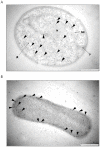Structural studies of planctomycete Gemmata obscuriglobus support cell compartmentalisation in a bacterium
- PMID: 24632833
- PMCID: PMC3954628
- DOI: 10.1371/journal.pone.0091344
Structural studies of planctomycete Gemmata obscuriglobus support cell compartmentalisation in a bacterium
Abstract
Members of phylum Planctomycetes have been proposed to possess atypical cell organisation for the Bacteria, having a structure of sectioned cells consistent with internal compartments surrounded by membranes. Here via electron tomography we confirm the presence of compartments in the planctomycete Gemmata obscuriglobus cells. Resulting 3-D models for the most prominent structures, nuclear body and riboplasm, demonstrate their entirely membrane - enclosed nature. Immunogold localization of the FtsK protein also supports the internal organisation of G.obscuriglobus cells and their unique mechanism of cell division. We discuss how these new data expand our knowledge on bacterial cell biology and suggest evolutionary consequences of the findings.
Conflict of interest statement
Figures




References
-
- Lindsay MR, Webb RI, Strous M, Jetten MS, Butler MK, et al. (2001) Cell compartmentalisation in planctomycetes: novel types of structural organisation for the bacterial cell. Arch Microbiol 175: 413–429. - PubMed
-
- Fuerst JA, Sagulenko E (2011) Beyond the bacterium: planctomycetes challenge our concepts of microbial structure and function. Nat Rev Microbiol 9: 403–413. - PubMed
-
- Fuerst JA (2005) Intracellular compartmentation in planctomycetes. Annu Rev Microbiol 59: 299–328. - PubMed
Publication types
MeSH terms
Substances
LinkOut - more resources
Full Text Sources
Other Literature Sources

